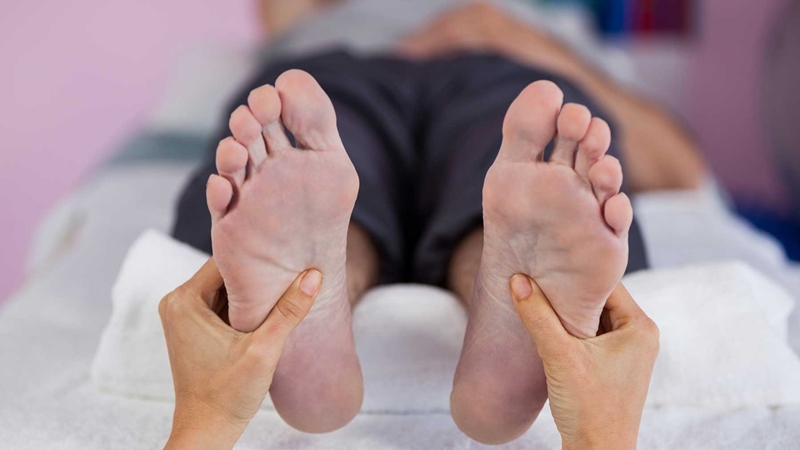Serious foot problems such as ulcers, infections, and bone and joint pain can arise in Type 2 diabetes patients.
Type 2 diabetes can easily go undetected if blood sugar levels are not properly managed. It can quietly disrupt sufferers lives with tiredness and frequent urination which are often seen as ‘normal’ everyday issues.
The type 2 diabetes can also cause diabetic neuropathy or nerve damage and ‘peripheral neuropathy which affect the feet. The Mayo Clinic warns: “Signs and symptoms of peripheral neuropathy are often worse at night,” and without proper care, serious foot problems such as ulcers, infections, and bone and joint pain can arise.
In India, out of 62 million people with diabetes, 25% develop diabetic foot ulcers. Of these, 50% become infected and require hospitalisation, and 20% ultimately need amputations. Diabetic foot ulcers account for over 80% of non-traumatic amputations annually in India.
Individuals with a history of diabetic foot ulcers have a 40% higher mortality rate over ten years compared to those without such a history.
Persistent diabetic foot ulcers are often caused by bacterial infections, and multidrug-resistant bacteria exacerbate the condition and lead to more severe outcomes.
The diverse ethnic and cultural backgrounds in India also influence the bacterial diversity and aetiology of diabetic foot infections.
Signs of type 2 diabetes in the feet
To prevent these severe complications, It is strongly advised regular foot examinations and everyone with diabetes should have their feet checked annually at their doctors for proper cure surgery.
Recognising the overall symptoms of type 2 diabetes is essential for early detection. Unfortunately, many people have type 2 diabetes without knowing it.
Other Symptoms of Type 2 Diabetes
- Blurry vision
- Excessive thirst and hunger
- Fatigue
- Excessive urination, including at night
- Numb or tingling hands or feet
- Slow wound healing, since diabetes can affect circulation
- Unexpected weight loss<
- Very dry skin
Type 2 diabetes symptoms often take several years to develop, and that some people may have no symptoms at all. That’s why it’s helpful to have your blood sugar levels checked regularly.
Causes of Type 2 Diabetes
Insulin resistance is the most common cause of type 2 diabetes. But why do some people become resistant to this hormone, while others do not? Researchers are working hard to figure that out. What they do know already is that there are certain factors that may play a role in how insulin is used by the body, specifically:-
Diet and Body Weight
Regular consumption of lower-quality foods that are high in added sugars, saturated fat, and sodium can increase your odds of developing type 2 diabetes, according to the exoerts. In part, that’s because these foods can lead to becoming overweight or having obesity, which is considered a major risk factor for diabetes. Excess weight can influence how hormones are regulated in the body, including insulin.
Genes
Type 2 diabetes can be hereditary. That doesn’t mean that if your mother or father has (or had) type 2 diabetes, you’re guaranteed to develop it, but it does mean you have a greater chance of it.
Although researchers know that you can inherit a risk for type 2 diabetes, they haven’t yet pinpointed which genes carry the risk. The medical community is hard at work trying to figure out the certain genetic mutations that lead to a risk of type 2. For example, the National Institutes of Health is tracking genetic variations that may play a role in different types of diabetes.
Lack of Exercise
Being generally sedentary contributes to diabetes by leading to weight gain. Also, lack of exercise can cause muscle cells to lose their sensitivity to insulin, making you more susceptible to developing type 2 diabetes. That’s why exercise is recommended for people who have diabetes, because it can improve blood sugar control, as well as reduce cardiovascular risk factors.
Who Is Most Likely to Develop Type 2 Diabetes?
According to the experts, you’re more likely to develop type 2 diabetes if you have one or more of these risk factors:
- You are age 35 or older
- You are overweight or have obesity
- You have a family history of diabetes
- You have a history of gestational diabetes<
- You have a low physical activity level
If you have type 2 diabetes risk factors, it’s advisable to get your blood sugar checked, even if you don’t yet have symptoms.
At a minimum, you should have an annual physical that looks at your blood sugar, cholesterol, and blood pressure. If there’s concern about diabetes, you can get a test of HbA1c (glycated haemoglobin) that assesses your average for blood sugar over a three-month period. Taken together, these results will let you know whether you need to make meaningful lifestyle changes or start on a treatment option.
Preventing Type 2 Diabetes
One of the most important ways to prevent type 2 diabetes is through diet, particularly true if you’ve been diagnosed with prediabetes, a condition in which you have higher-than-normal blood sugar levels but they’re not yet high enough to qualify as diabetes. Unlike type 2 diabetes, which is a chronic condition, prediabetes can be reversed, that’s why taking control at this stage is so important.
About 80% of blood sugar control is dietary, so it’s worth putting a great deal of effort into this aspect of prevention. Having a good baseline knowledge of how foods affect blood sugar is essential.
It’s important to know that it isn’t just unhealthy options like fried foods, sweetened drinks, and sugary desserts that raise your blood sugar. Even some healthful choices like fruits and whole-grain breads may affect your blood sugar, so it is suggests talking with a dietitian or certified diabetes educator if you have prediabetes to devise an eating plan that helps keep your glucose stable.
Another important part of prevention is to get more physical activity. In addition to structured exercise like going to the gym or doing fitness classes, simply moving more often throughout the day is helpful for regulating blood sugar on a consistent basis.
Outlook With Type 2 Diabetes
Having type 2 diabetes puts you at increased risk of serious health outcomes like heart disease, nerve damage, eye problems, and kidney disease. However, those complications usually occur with diabetes that is not being well controlled.
If you’re managing your diabetes and following healthy lifestyle habits, that goes a long way toward preventing significant health issues. The key is to stay on top of your diabetes care and take a very active role in managing your condition.
Bottom Line
Type 2 diabetes isn’t curable, but it can be managed and may be preventable for some people. Knowing your risk factors, getting your blood sugar levels assessed, and putting habits into place that are known to counter insulin resistance can all be important steps toward supporting your health and staving off or managing diabetes. If you do develop type 2 diabetes, diligent management of the condition—which may include medications, insulin, dietary changes, and other lifestyle steps—can help prevent major health complications like kidney disease or cardiorespiratory issues. All to say: You can’t always keep type 2 diabetes from developing, but much is in your control when it comes to how the condition will play out.





